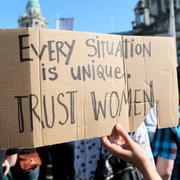
Abortmotståndarna erkänner sig besegrade
Motståndarna till en mjukare abortlagstiftning på Irland erkänner sig besegrade. Det säger John McGuirk, talesperson för kampanjen ”Rädda det åttonde tillägget”, enligt Sky News.
Två vallokalsundersökningar har visat att mellan 68 och 69 procent av väljarna har röstat för en förändring av lagstiftningen, som i dag är bland Europas hårdaste. Abort tillåts bara när kvinnans liv är i fara och inte när fostret har svåra skador eller när graviditeten tillkommit på grund av våldtäkt eller incest.
Sedan 1983 har 170 000 irländska kvinnor rest utomlands för att genomföra aborter, enligt siffror från hälsodepartementet.
bakgrund
Abortlagarna på Irland
Wikipedia (en)
Abortion in Ireland is illegal unless it occurs as the result of a medical intervention performed to save the life of the woman. The right to life of the unborn is protected by Article 40.3.3º of the Constitution (commonly called the Eighth Amendment) and the Protection of Life During Pregnancy Act 2013 provides for an offence of destroying unborn life, with exceptions only in the case of a risk to the life of the woman, including a risk of suicide. The Constitution also protects the right to travel to obtain an abortion outside the state and to receive information about services outside the state. The information available is regulated by legislation.
Abortion had been prohibited in Ireland by the Offences against the Person Act 1861, a statute of the United Kingdom which stayed in effect after independence in 1922. The Eighth Amendment was added to the Constitution by referendum in 1983 after concerns that laws prohibiting abortion could be threatened by legal action in a similar manner to laws prohibiting the importation of contraception. In 1992, the Supreme Court held in the X Case that a thirteen-year-old girl who had become pregnant as a result of rape could be permitted to obtain an abortion in the state. There were unsuccessful referendums in 1992 and in 2002 which would have overturned this decision and removed the risk of suicide as a ground for an abortion.
There has been a range of litigation in both Irish and international courts on abortion in Ireland. In A, B and C v Ireland (2010), the European Court of Human Rights found that Ireland had violated the European Convention on Human Rights by failing to provide an accessible and effective procedure by which a woman can have established whether she qualifies for a legal abortion under Irish law. This led to the current legislation passed in 2013. A number of cases related to whether an abortion was permissible in cases of fatal foetal abnormalities occurred.
Irish abortion law received worldwide attention on the death of Savita Halappanavar in 2012, who had been denied an abortion while suffering a septic miscarriage. This increased calls to repeal the constitutional protection for the life of the unborn. The constitutional and legislative provisions were discussed at a Citizens' Assembly in 2016–17, and at an Oireachtas committee in 2017, both of which recommended substantial reform.
The government has proposed the Thirty-sixth Amendment of the Constitution Bill, which if passed in a referendum on 25 May 2018 would replace the current provisions of Article 40.3.3º with a clause allowing legislation regulating the termination of pregnancy.
As of 2010, the abortion rate was 4.5 abortions per 1,000 women aged 15–44 years.
Omni är politiskt obundna och oberoende. Vi strävar efter att ge fler perspektiv på nyheterna. Har du frågor eller synpunkter kring vår rapportering? Kontakta redaktionen



